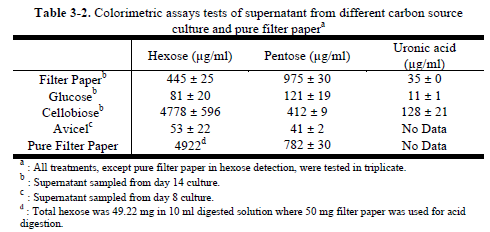- Glucose was detected in the cellobiose grown culture, but not in cellulose-grown cultures, suggesting that cellobiose is hydrolyzed extracellularly rather than being directly assimilated, and that cellulose may not be degraded via cellobiose. Also, cellobiose-based cultures caused greater acidification of the medium than glucose or cellulose grown cultures.
- C. hutchinsonii produces and releases slimy substances when cultured in liquid, making the medium viscous. Slime production in C. johnsonii was reported to increase with culture maturity [Follett & Webley 1965]. The slime is reported to consist of polysaccharides composed of glucose, mannose, arabinose, xylose and glucuronic acid residues [Martin et al. 1968].
Cells in cellobiose-DSM3T medium might hydrolyze cellobiose first, releasing glucose, and then use glucose for growth. This suggested that cellobiose was not assimilated directly by cells. But the cells can't turn cellulose into cellobiose. Also, the cellobiose culture showed that almost no other mono- or oligo-saccharides were produced in the culture.
The spots from the filter paper culture did not exactly match any of the sugar standards; however, the color matched the color of the xylose and arabinose standards. Also, oligosaccharides composed of pentose. Hexoses and pentose accumulated slowly in cellulose (filter paper) culture
- Cell growth with filter paper was observed after 3 or 4 days as translucent yellow areas on the filter paper strips.
C. hutchinsonii degraded filter paper completely and produced translucent area with yellowish slime.
Cells did not transfer to adjacent filter paper strips which suggested that they were unable to cross intervening agar surfaces. Degradation could be initiated either from the edge or the interior surface of filter paper strips. The plates could be maintained by putting new filter paper strips on the yellow areas.
The ability of cells to spread over agar plates supplemented with glucose or cellobiose, but not between filter paper strips on plates lacking such supplementation, suggests that gliding is associated with substrate uptake or requires constant energy input
- The maximum cell density achieved on filter paper was much lower than that seen with glucose. The growth in filter paper cultures gradually increased from day 3 and stabilized after day 9 at OD.
- Colorimetric assays for metabolic product determination: Colorimetric assays are widely used for quantification of monosaccharides, deoxy-sugars and uronic acids. The general concept is based on forming furfural or related chemicals in strong acids, sometimes with heating
high-performance liquid chromatography (HPLC)
...
